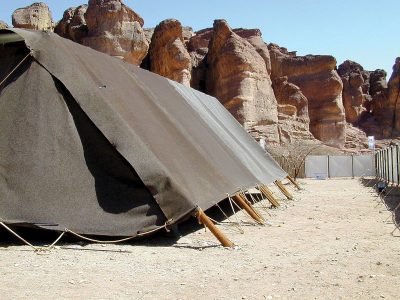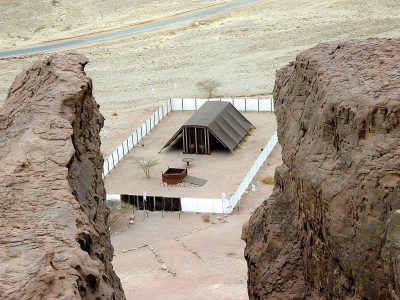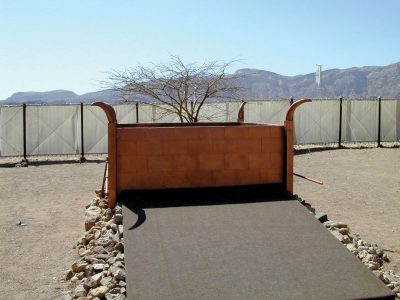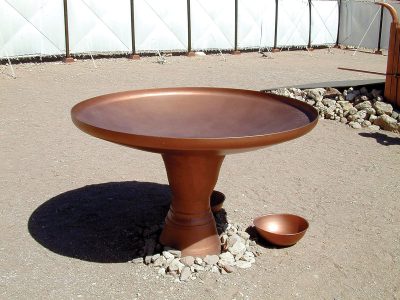
by: Rev. Cheryl L. Hauer, International Development Director
Nachmanides, 13th-century Jewish sage and scholar, calls Exodus “The Book of Redemption” because it begins with the Jewish people in slavery to the Egyptian, traces their remarkable deliverance, and comes to an end with the establishment of the Tabernacle in the wilderness. Once Moses had completed this amazing structure, according to all that God had told him, the glory of the Lord filled it so that even Moses himself was not able to enter (Exod. 40:33–35). Further, the Scriptures tell us that the cloud covered the Tabernacle by day, and the fire was over it by night in the sight of all the house of Israel (vv. 36–38). What a glorious picture this creates of God Himself, hovering over His people, protecting and guiding them, leading them in and out “throughout all of their journeys.”
The King of the universe had chosen to live among His people, and His presence was palpable and visible. In fact, Exodus 25:8 tells us the reason that God brought them out of Egypt?that He might dwell among them. There could have been no clearer statement to the Israelites that their God was a God of incomprehensible grace and mercy than His constant presence in their midst. Equally as clear, however, was His uncompromising holiness. Even Moses, who had been intimately involved in every aspect of the building of the Tabernacle?he and the God of Hosts partners in the endeavor?remained outside the tent.
 The Hebrew word mishkan is translated “Tabernacle” and means “tent” or “place of dwelling.” What a remarkable place it must have been, completely collapsible and portable, yet containing tons of gold, silver, and bronze and the finest of woven fabric. It was profoundly holy and sacred, yet a joyful meeting place for God and His people. It was the center of worship and the sacrificial system for all the camp of Israel, yet a powerfully visible “traffic signal” of sorts, telling the people when to stop and when to go. It was indeed a splendor to behold and was a visual aid in keeping with the pattern God had set for dealing with His people from the very beginning of time.
The Hebrew word mishkan is translated “Tabernacle” and means “tent” or “place of dwelling.” What a remarkable place it must have been, completely collapsible and portable, yet containing tons of gold, silver, and bronze and the finest of woven fabric. It was profoundly holy and sacred, yet a joyful meeting place for God and His people. It was the center of worship and the sacrificial system for all the camp of Israel, yet a powerfully visible “traffic signal” of sorts, telling the people when to stop and when to go. It was indeed a splendor to behold and was a visual aid in keeping with the pattern God had set for dealing with His people from the very beginning of time.

His word to Adam had been to “multiply,” to Noah to “build,” and to Abraham to “get out…from your father’s house, to a land that I will show you” (Gen.12:1). His relationship with Israel would be one of dynamic interaction, a powerful and vigorous association based on one action-packed encounter after another between the Lord and His chosen ones. Never would He encourage them to sit idly by the wayside of life and contemplate His nature, nor require that they merely lend mental assent to His precepts.
He would lead, and His people would follow. He would deliver with a mighty hand and an outstretched arm. He would show them great things and manifest His power on their behalf. His people would be a great nation, His agents to enlighten all other nations, and they would be a people on the move! He would call them to great exploits, empower them to accomplish the miraculous, lead them into battle, and guarantee their victory. The totality of their relationship could be summed up in one word?action!
God knew that visual evidence of His presence with them was essential to the Israelites if they were to persevere in this relationship. His brief encounter with Moses on Mount Sinai certainly proved that. After less than 40 days of not seeing or hearing from Moses, or from the Lord, the people reverted to the Egyptian influence in their lives with alarming ease and created a god that they could see, one whose presence with them could not be denied (Exod. 32:1). Now, the Tabernacle?the glorious resting place for the Shekinah(God’s presence manifested in the cloud)?would serve as an intricate visual aid, a constant reminder of the presence of the Lord in the midst of His people.
In Jewish tradition, it is believed that the consecration of the Tabernacle at God’s instruction was a sign of healing in the aftermath of the tragedy of the golden calf. Nachmanides wrote that the sublime secret of the Tabernacle was that the presence of God, which had hovered over the mountain at Sinai, would now be placed on permanent display, constantly in the midst of the camp. This was seen as a sign of divine benevolence. God had forgiven them for their tragic act of idol worship. He was with His people, and they with Him.
The minutely detailed instructions for the building of the Tabernacle were given to Moses by God Himself (Exod. 25–27, 30). In addition to his role as leader and deliverer of the Israelites, Moses now became the manager of a project that would involve thousands of pounds of gold, silver, and bronze alone (Exod. 38:24–29, one talent=34 kilograms or 76 pounds), not to mention innumerable amounts of other resources, huge crews of workmen and craftsmen, and countless hours spent in planning and building.
 And, of course, before any of that could happen, Moses would be the one to “sell” the idea to the Israelites, helping them to catch God’s vision for this truly remarkable endeavor, inspiring them to give generously of all that would be needed to bring the venture to completion. And inspire them he did. God only required offerings for the building of the Tabernacle from those whose hearts were moved and who could give willingly to the work. Exodus 35 tells us that the people were so inspired that they brought huge offerings, morning after morning after morning, until the workmen complained that they had too much and needed the people’s benevolence to end (Exod. 36:4–5). Here, Nachmanides says, is the key to the Tabernacle “transaction.” The people had given of their gold once before, unfortunately, to build the golden calf. But now, their willingness to give abundantly to create a dwelling place for the Lord proved their desire to turn away from the gods of Egypt once and for all and welcome the presence of the One True God into their midst. Their generosity would, in a sense, “atone” for their idol worship.
And, of course, before any of that could happen, Moses would be the one to “sell” the idea to the Israelites, helping them to catch God’s vision for this truly remarkable endeavor, inspiring them to give generously of all that would be needed to bring the venture to completion. And inspire them he did. God only required offerings for the building of the Tabernacle from those whose hearts were moved and who could give willingly to the work. Exodus 35 tells us that the people were so inspired that they brought huge offerings, morning after morning after morning, until the workmen complained that they had too much and needed the people’s benevolence to end (Exod. 36:4–5). Here, Nachmanides says, is the key to the Tabernacle “transaction.” The people had given of their gold once before, unfortunately, to build the golden calf. But now, their willingness to give abundantly to create a dwelling place for the Lord proved their desire to turn away from the gods of Egypt once and for all and welcome the presence of the One True God into their midst. Their generosity would, in a sense, “atone” for their idol worship.
 If Moses was God’s Tabernacle project manager, there was another who was its chief craftsman . Moses had a right-hand man, and his name was Bezalel. God explains to Moses in Exodus 31 that He had called Bezalel to this work, promising to fill him with the Spirit of God, with wisdom, understanding and knowledge (v. 3)?everything he would need to complete the work according to God’s specifications. Scripture further tells us that Bezalel was able to assemble a crew that were also men of wisdom, understanding and ability in every craft, all called and equipped by the Lord of Hosts to create the place where He would dwell among men.
If Moses was God’s Tabernacle project manager, there was another who was its chief craftsman . Moses had a right-hand man, and his name was Bezalel. God explains to Moses in Exodus 31 that He had called Bezalel to this work, promising to fill him with the Spirit of God, with wisdom, understanding and knowledge (v. 3)?everything he would need to complete the work according to God’s specifications. Scripture further tells us that Bezalel was able to assemble a crew that were also men of wisdom, understanding and ability in every craft, all called and equipped by the Lord of Hosts to create the place where He would dwell among men.
Bezalel must have been a remarkable man indeed, called to serve side-by-side with Moses the Deliverer and clearly anointed by God to accomplish this most holy of tasks. Although there is precious little Christian teaching about him, Jewish tradition has much to say about Bezalel, beginning with his lineage. We are told in Exodus 31 that he is the son of Uri, the son of Hur, and here the sages see a clue as to the reason for God’s choice. Hur is a familiar name; he has appeared in Scripture before. In Exodus 17, for example, when the Israelites are fighting against the Amalekites, it is Hur that helps Aaron support Moses’ arms until the victory is secured. And when Moses tells the elders of Israel that he is venturing up Sinai to hear the Word of the Lord, he tells them Aaron and Hur will be in charge in his absence.
Clearly, Hur had to be a man of character and integrity to have been so trusted by Moses. His dedication to the God of Israel and to His people were without question, and his household most assuredly would have lived a life of covenant commitment to the One True God?a commitment, the rabbis say, that overshadowed even the loyalty of Aaron. The Midrash (a collection of Jewish commentaries on the Hebrew Bible) notes that once Moses left the camp to climb the mountain, Hur’s name is never mentioned in the Torah (Gen.–Deut.) again, except in the lineage of Bezalel. Jewish tradition links this mysterious disappearance to the incident of the golden calf, and the Midrash says: “When the Israelites wished to do that deed [create an idol to worship], they said to Aaron, ‘Come make for us a Lord.’ Hur, the son of Caleb, arose and chastised them. They immediately arose and killed him.” Hur was a man, they say, of such righteousness that he willingly gave his life rather than participate in such an atrocious act. Surely, he would have passed that righteous heritage to his son Uri, who would have influenced Hur’s grandson Bezalel to love and serve the God of Israel with the same fearless dedication.
The Talmud (rabbinic commentary on Jewish tradition and the Hebrew Scriptures) says that Bezalel was such an extraordinarily gifted person that he was only 13 years old when God called him to begin work on the Tabernacle, and the rabbis teach that there is a clear connection between Hur’s death and God’s selection of Bezalel. Having Hur’s grandson represent the people of Israel in this righteous endeavor further indicated God’s forgiveness for their reprehensible actions at Sinai. Even the meaning of his name, “in the shadow of the Lord,” reflects the purpose for which he was called.
It is certainly difficult for 21st-century readers of the Bible to comprehend what it must have been like for those ancient people to walk in the heat of the desert, day after day, guided by the cloud, carrying with them the visible, perceptible, tangible presence of the Most High God. We can easily skip over the many chapters in the Hebrew Scriptures, which discuss the building of the Tabernacle, thinking they are not relevant to our modern lives. But the significance of the mishkandid not end when it was finally replaced after 440 years by the Temple in Jerusalem as a permanent place of worship. For Jews and Christians, the Tabernacle remains to this day an object lesson on redemption. In God’s detailed instructions for its construction, we find windows not only into the desert life of the ancient Israelites but also into the very heart of God and the requirements for mankind’s relationship with Him.
 Many Christian scholars believe that a true understanding of the Christian Scriptures and the redemptive work of Yeshua cannot be attained without a deep knowledge of the Tabernacle and its importance in the life of Israel. In each element of Tabernacle worship, so painstakingly crafted by Bezalel and his team, some aspect of the life and work of Yeshua is seen. A few examples might be:
Many Christian scholars believe that a true understanding of the Christian Scriptures and the redemptive work of Yeshua cannot be attained without a deep knowledge of the Tabernacle and its importance in the life of Israel. In each element of Tabernacle worship, so painstakingly crafted by Bezalel and his team, some aspect of the life and work of Yeshua is seen. A few examples might be:
The brazen altar can be seen to represent the substitutionary death of Yeshua on the cross and the importance of blood sacrifice.
In this paradigm, the laver denotes the need for purification and the sanctification that comes through the study of the Word of God.
 The menorah can be seen to symbolize Yeshua as the light of the world, shedding light on a dark and lonely earth.
The menorah can be seen to symbolize Yeshua as the light of the world, shedding light on a dark and lonely earth.
The showbread is often understood to represent God’s desire to fellowship with His creation as is embodied in the sharing of a meal. In the Christian scriptures, Yeshua said he was the bread of life.
The Christian Scriptures refer to believers as a priesthood and to Yeshua as their high priest. The same call to a life of purity, commitment and obedience that God expressed to His royal priesthood in the book of Exodus pertains to the life of the believer today.
Although countless books and commentaries have been written by Christians throughout the ages about the Tabernacle, many Christians are not aware of the modern-life lessons that the Jewish people today find in those same chapters of Exodus. A few examples:
Just as Moses took a careful accounting of what materials were given for the construction of the Tabernacle and how they were used, each person must regularly do the same through a cheshbon hanefesh, a spiritual accounting. A careful daily examination of one’s behavior and how it represents God to the world is necessary in order to use the gifts we have been given to the glory of His name. As the presence of the Lord rested in the Tabernacle for all the Israelites to see, is my behavior displaying the presence of God to those around me?
The rabbis teach that a Hebrew reading of Exodus 40 indicates that Moses dissembled and reassembled the Tabernacle three times in one day! Why would this be? The Midrashsays it is to teach a vital lesson. Although we spend our lives toiling and struggling to build ourselves into sanctuaries?vessels worthy for the divine presence to rest within?there still may be times that we stumble and fall. Despite our failures, however, we must never give up. Instead, we must rouse ourselves immediately and rebuild.
 In Exodus 28:38, the high priest is instructed to wear a head plate that “shall always be on his forehead.” The rabbis understand this direction not so much as addressing where it is worn, but rather how it is worn. It is not enough that it be on the forehead; it must be always on his mind. The high priest must be constantly aware of the message of the plate?holiness to God?in his service, in his life. He must never be like the man whose thoughts revolve around business and life while mumbling daily prayers.
In Exodus 28:38, the high priest is instructed to wear a head plate that “shall always be on his forehead.” The rabbis understand this direction not so much as addressing where it is worn, but rather how it is worn. It is not enough that it be on the forehead; it must be always on his mind. The high priest must be constantly aware of the message of the plate?holiness to God?in his service, in his life. He must never be like the man whose thoughts revolve around business and life while mumbling daily prayers.
The sages teach that the Divine Presence manifested in the Tabernacle throughout the lives of the forefathers creates a paradigm for all the generations of their children. Every generation, as well as every individual, experiences the journeys of the forefathers in the wilderness, even though the “wilderness” may be unique to each of us. We have our high points, as well as great difficulties and low points. One who holds fast to the commitment of living life with the goal of godliness in mind, going only in the direction that the cloud is leading, remains consistent regardless of the changes or difficulties that may be encountered. This person is traveling through life with the Divine Presence truly resting upon him or her.
Just as there is much in the Torah about maintaining the sanctity of the Tabernacle, so it is with the life of the Jewish person. The Torah advocates the partaking of the physical world, but using it as a means to an end. Recognizing that some of the pleasures of this world are a gift from God to be gratefully embraced, while walking in purity of heart in service to God, is true holiness.
The Jewish commentary Pirke Avot teaches that Jewish people must seek out the Divine Presence since there is no physical Tabernacle today. If ten sit in Torah study together, He is there. If five, or just three, are together on His behalf, He is there. This is so even if there are only two, since Exodus 20:24 says, “In every place where I cause My name to be mentioned, I will come and bless in the midst of you”(a Jewish translation).
Finally, the sages sometimes teach that the building of the mishkanwas analogous to the creation of the universe itself:
1st day—The heavens were spread as a curtain, as were the curtains over the mishkan.
2nd day—The upper and lower waters were separated as the curtain separates the Holy Place from the Holy of Holies.
3rd day—The lower waters were gathered just as the people were gathered at the laver.
4th day—The sun, moon, and stars were created to give light as did the menorah.
5th day—Fish and birds were created as were the cherubim.
6th day—Adam was created in Eden as Aaron was dedicated as High Priest.
7th day—God rested just as Shabbat (Sabbath) rests upon the mishkan.
Truly, the Tabernacle has been a critical element in the relationship between God and His people since its construction thousands of years ago. Hundreds of nameless men and women labored with Moses and Bezalel to meticulously follow God’s instructions and create a resting place for His presence. How critical was the contribution made by each one of them to the redemptive faith of Jews and Christians throughout the ensuing generations! Though its actual construction and remarkable physical beauty remain somewhat of a mystery to us today, the essential message has remained the same for millennia: God loves His people and desires a sanctuary?carefully constructed according to His plan, purified by His Word, following His leading?in which He can dwell in joyful fellowship. May our hearts and lives be so!
“It can be compared to a King who possessed only a daughter. When one of the princes of a far-away kingdom took her to be his wife and wanted to remove her to his own country, the King pleaded with his son-in-law: ‘As she is my only daughter, I cannot part with her for good; nor as she is now your wife, can I prevent her from going with you. I have but one request. Wherever you make your home, please reserve a room for me where I can come occasionally to be near my beloved daughter.’ This is what God said to Israel: ‘I have given you the Torah. I cannot take it away from you, yet I cannot part with it. So wherever you are on earth, construct for Me a house wherein My presence may dwell with you, My beloved, and My Torah’” (Exodus Rabba).
DeWitt, Roy Lee. Teaching from the Tabernacle. Chatham, IL: Revival Teaching, 1986.
Edersheim, Alfred. The Temple, Its Ministry and Services.Peabody, MA: Hendrickson Publishers, 1994.
Frankel, Ellen and Betsy Platkin Teutsch. The Encyclopedia of Jewish Symbols. New Jersey, London: Jason Aronson, Inc., 1992.
Levine, Moshe. The Tabernacle: Its Structure and Utensils. London, Jerusalem, New York: Soncino Press Limited, by Melechet Hamishakn, Tel Aviv, Israel, 1989.
Unterman, Alan. The Dictionary of Jewish Lore & Legend. New York: Thames & Hudson, 1991.
www.aish.com, The Architect, by Rabbi Ari Kahn
Photo Credit: www.bibleplaces.com/Todd Bolen
All logos and trademarks in this site are property of their respective owner. All other materials are property of Bridges for Peace. Copyright © 2025.
Website Site Design by J-Town Internet Services Ltd. - Based in Jerusalem and Serving the World.